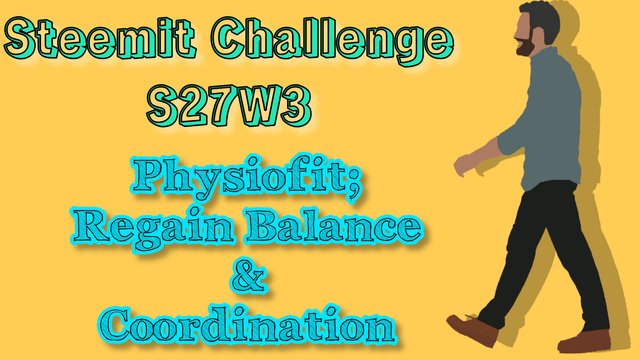Steemit Learning Challenge-S27W3; Physiofit; Regain Balance & Coordination Challenge
A few days ago, I was watching the Discovery Channel. They were discussing how a Cheetah maintains balance while running. I was surprised to know that their tail plays a key role when they are running.

| Image Source | Edited by InShot |
|---|
Welcome to the third week of the Steemit Challenge, Season 27. This week, our beloved mentor, @ashkhan discussed Balance, its types, coordination, and its types, pathophysiology, and how we can prevent a patient who has a balance and coordination problem. In this article, I will discuss what I learn this week.
Balance, Coordination, types, and pathophysiology.
Balance
Balance is to maintain our body posture and stability with the centre of gravity based on our movement, motion, and position. No matter whether we are standing or moving, maintaining our body posture and stability is called balance.
Types
Usually, there are two types of balance.
Static Balance
Static balance is when we are not moving, and keeping our body posture stable. Like when we are standing on both feet or on one foot. It is the coordination between the visual, vestibular, and proprioceptive systems that helps the body sense its position and make stable adjustments. Imagine, Virat Kohli played his favourite cover drive and hung in that position for a moment. The perfect example of static balance.
Dynamic Balance
Dynamic balance is when we are in motion and at the same time we keep our body posture stable. This is the coordination between the muscles, joints, eyes, and the inner ear. Usain Bolt running in the Olympics, focusing on the finishing line, and finishing that within 9.63 seconds. The perfect example of dynamic balance.
Coordination
Coordination is the communication between our body parts when we are balancing our body during the time of in motion or standing. Several parts of our body like the visual, vestibular, proprioception, eyes, and brain, etc work together to keep our balance. This is the process we call coordination.
There are three types of Coordination.
- Motor Control To control movements and maintain posture while moving or standing still. Motor control helps us to do silly things like picking up something to heavy things like running or dancing.
- Time Coordinationg the movements with accuracy. Like, our body parts coordinated together to a specific move at the same time to make a perfect posture, and keep stable.
- Rhythm Movements in a rhythmic pattern. Like running at the same pace, positioning the body parts rhythmically.
Pathophysiology
Several parts of our body integrate during coordination. If any of the parts failed to work properly cause an imbalance in the body. Let me discuss about few key parts of our body that help us coordinate.
Vestibular System
Detects the change in the position of the head. Located in the inner ear.
Proprioception
Sense of the position of the body. Sensors are in muscles, tendons, and joints.
Visual & Central Nervous System
Eyes, that the organs that work as the visual nervous system and send signals to our brain, and reverse signals come from the brain to all other parts that react.
If any parts related to coordination are not working properly, it causes an imbalance in our stability. Such as weak muscles, joints, and tendons, or nervous and several sensors.
Old age, when joints and muscles become weak, makes proprioception less effective. Heart failure caused by alcohol or another reason, makes the central nervous system weak.
Causes that lead to balance and coordination impairment.
I know a patient who has an imbalance disease. In his case studies, I found that he was an alcoholic for a long time. He had suffered a heart attack twice. After those serious conditions, he is now suffering from this kind of problem.
Alcohol abuse can lead to heart problems and damage the cerebellum. The cerebellum is the part of the brain, the central nervous system that controls our balance, posture, movements, and coordination. If someone is an alcoholic, there is a high chance that they to lose control over balance and coordination.
Performing the above-mentioned physiotherapy management
As I don’t have any volunteers or patients to practice, I, myself performed some hurdles in walking, and squats to improve balance, and coordination.
At first, I tried side walking. From left to right. Then, right to left. This helps our visual nervous system coordinate with the central nervous system. The vestibular system helps us stay still while proprioception keeps working to smooth our movements.
Then I tried reverse walking. It reminded me of my young days when I loved to dance at public functions. That time, I exercised reverse walking to keep balance while performing. I wasn’t aware that it was clinically approved.
Then I performed the hard one. Single-leg squats. I saw athletes training for this. I had no idea why. Now I know. Well, I found it a bit tough to do. I failed several times. At the end, I improved a bit.
| Invitation | @kibreay001 @narocky71 @impersonal |
|---|